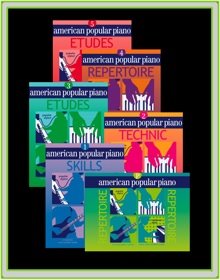This was a workshop specifically for private piano teachers and we were lucky to be able to use the concert hall (and Steinway grand) at Leighton Park School, a Quaker independent school set in rolling parkland not far from the centre of Reading (www.leightonpark.reading.sch.uk) Every teacher present was already familiar with my name and with Microjazz and other Boosey & Hawkes’ materials; none of them had come across American Popular Piano before. They had some initial questions about the series, for example:
Q: Why is the term “American” in the series’ name?
A: We have used a range of popular styles in APP with which America has become strongly identified
Q: How would you persuade a parent that 4 books per Level is a justifiable investment?
A: We hope that the usefulness of all the elements in APP across an entire year will prove to be in fact very good value for money!
Here are the some of the teachers who came to the workshop:

Teachers at the Reading workshop
I began by playing some APP pieces – I find that if people like the pieces right away, you’re in with more of a chance!

CN plays..
I then went on to give an overview of the present state of piano teaching and the difficulties faced by teachers trying to compete for students’ attention in the face of homework, sport, computer games and other activities perceived as more “cool” than piano-playing. There was some lively discussion about why students give up at various stages and we touched on the fact that students often play a range of music on the piano but listen to a completely different range of music back at home.. I then explained that APP is designed to use music in styles familiar to the student, but without sacrificing the fundamentals of good piano playing, sight-reading and ear-training.
I then moved through the Repertoire books, illustrating the 3 main categories – lyrical pieces, rhythmic pieces and ensembles – with some help from the audience as well as video clips of student performances. Here’s one of the teachers who was brave enough to come up and play for the group:

A teacher helps to demonstrate APP.
The teachers liked the Repertoire books, especially the fact that there are Ensembles, with teacher accompaniment and backing track, at every Level. But it was the Etudes books that really got their attention – a way of teaching improvisation that virtually anyone can feel comfortable with. I had a teacher improvising – she was actually quite an experienced improviser already, but she found the way APP keeps things very simple and ordered very useful. And the group agreed that the range of styles and the use of “authentic” left-hand voicings (generally in inversion) was both stimulating musically and applicable right away with students.
Another question came up – there was an ABRSM examiner there and she asked how the APP material (and approach) related to the ABRSM jazz syllabus. I said that there were inevitably overlaps (particularly blues pieces) but that the overall range of styles in APP is very different from the ABRSM syllabus – much more popular music than jazz style-wise. APP also progresses much more steadily from one Level to the next than any UK syllabus. I feel that APP is a good way of getting students (particularly at an absolute beginner level) comfortable with improvisation, so it is a useful way of preparing to work on more specifically jazz material.
We had a break at this point and the teachers looked at the books supplied by Score Store. Here are some enthusiastic teachers perusing the materials:

Teachers looking at the books
In Part 2, I did a quick overview of the Boosey & Hawkes’ materials, obviously referring to Microjazz (some teachers were new to the Microjazz Trios, for 6 hands) but also to Microstyles, the Concert Collections, the Easiest Way To Improvise, the Essential Guides, the Preludes Collections and the new Microswing, MicroLatin and MicroRock books. I played quite a few pieces, some with tracks and was able to get the teachers roughly up to speed with what I’ve written since 1983!
This was a very friendly and positive group and I’d like to thank both Score Store Wokingham (www.scorestore.co.uk) and Leighton Park School for hosting the event so well. I hope the teachers who bought APP sets to try out with their students will come back to the websites (www.christophernorton.com and www.americanpopularpiano.com) and let us know how they are getting on!
Some final pictures:
 The range of books ...
The range of books ...

Absorbed!

 As the picture indicates, the workshop was in a church – there are a number of striking historic churches in Auckland and this one, St Lukes Church in Remuera, is really very attractive, especially on a sunny day. The stained glass and the dark wood make for a very distinctive combination.
As the picture indicates, the workshop was in a church – there are a number of striking historic churches in Auckland and this one, St Lukes Church in Remuera, is really very attractive, especially on a sunny day. The stained glass and the dark wood make for a very distinctive combination.
 Thanks to Liz Calvert of the Auckland RMT for doing such a fantastic job organising this event. I hope to see you all again soon!
Thanks to Liz Calvert of the Auckland RMT for doing such a fantastic job organising this event. I hope to see you all again soon!





















































